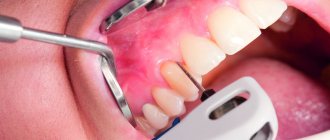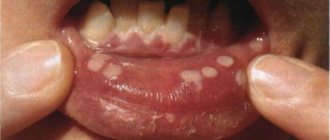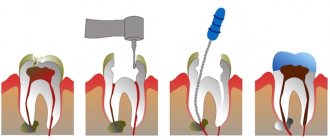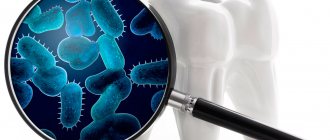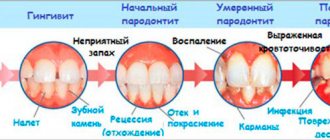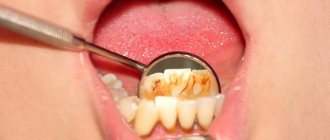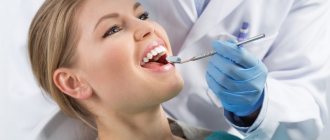Gingivitis is an inflammatory process in the gum tissue that affects the surface tissue, while the ligament that holds the tooth in the jaw is not damaged and the teeth do not become loose. But this does not mean at all that this disease is not dangerous: if gingivitis is not treated, over time it will develop into periodontitis. Then it will be more difficult to stop the spread of inflammation and save teeth. Advanced gingivitis can also provoke periodontal disease – dystrophic changes in the gum tissue.
Gingivitis often occurs in teenagers and pregnant women. In this category of patients, the disease is more complex and more often causes complications. This is due to hormonal changes in the body.
Types of gingivitis
There are several classification options. But the location is divided into generalized (general, when all the gums or most of them are affected) and local (a small area of the gums near one or more teeth is inflamed) gingivitis.
There is also acute gingivitis (primary disease, which resolves with pronounced symptoms, the patient’s well-being deteriorates sharply). If a person does not go to the dentist and do not cure the disease, or does not complete the treatment, gingivitis becomes chronic. In this case, the symptoms appear less pronounced, the patient may not be bothered by anything for a long time - except for bad breath and slight bleeding during intensive brushing of the teeth. Periodically, chronic gingivitis worsens - during this period the clinical picture is similar to the acute course of the disease.
Depending on the severity there are:
- Mild degree, when inflammation covers only the gingival papillae;
- Medium – with it, almost the entire free part of the gum becomes inflamed;
- Severe, during which the disease covers both the free and alveolar parts. The risk of complications in this case is many times higher, and treatment will take longer.
Finally, there are several types of the disease itself:
- Catarrhal gingivitis is the most common and simplest acute form, in which the disease affects only soft tissues and does not reach the gums. The gums swell and bleed. Occasionally, pain is added. This form is easily treated locally.
- Simple marginal gingivitis is an inflammation of the superficial tissues of the gums, often caused by poor personal hygiene. Occurs mainly in children.
- Ulcerative gingivitis is characterized by ulceration of the gingival papillae, as a result, painful sensations appear immediately, the patient’s temperature may rise to 37.5 degrees, and health deteriorates. The pain intensifies when chewing food, especially hard food, and occurs while brushing your teeth. There is bleeding, swelling of the gums, and bad breath, which indicates the active proliferation of bacteria. If the patient does not receive qualified treatment, the disease may develop into Vincent's ulcerative-necrotizing stomatitis, in which dead areas of tissue form.
- Acute necrotizing Vincent ulcerative gingivitis is caused by a number of anaerobic bacteria (fusobacteria, treponema, spirochete, borellium), which causes necrosis (death) of the gingival papillae. It occurs with insufficient hygiene, but most often in the presence of other diseases that cause weakened immunity (frequent sore throats, flu, and also as a concomitant disease with tuberculosis and AIDS).
- Hypertrophic gingivitis is accompanied by tissue proliferation against the background of an inflammatory process. In this case, conservative treatment does not help; the patient requires surgery to remove part of the gum. There are two forms: edematous and fibrous. The edematous form of hypertrophic gingivitis is accompanied by an increase in tissue volume due to edema, the gingival papillae remain loose, and surgery is not required in most cases. Hypertrophic gingivitis in fibrous form is associated precisely with the growth and compaction of gingival tissue.
- Atrophic gingivitis , unlike hypertrophic gingivitis, is characterized by a decrease in gum volume. Most often this is due to impaired nutrition and blood supply to tissues, severe hypovitaminosis.
- Hyperplastic gingivitis is accompanied by the growth of gingival papillae, an increase in volume and blue discoloration of the gums. It usually occurs against the background of endocrine disorders and during the period of hormonal changes in the body.
- Desquamative gingivitis is characterized by intense desquamation of the gingival epithelium and severe redness of the gums.
Herpetic stomatitis: treatment in children and adults
It usually takes about 1 week to fully recover from herpetic stomatitis, but complete healing of ulcers (erosions) can last up to 12-14 days. During this time, the patient is recommended a liquid diet consisting of slightly chilled liquid foods, which should also not contain acid. As we said above, the treatment provided will depend on the severity of the clinical manifestations.
- In adults (especially mild forms of the disease), you can generally do without any specific treatment, i.e.
without taking tableted antiviral drugs. In this case, you can limit yourself to rinsing your mouth using antiseptic solutions with an antiviral effect (for example, Miramistin or Hexoral), and in the presence of herpetic rashes, including on the lips and skin around the mouth, use Zovirax Duo-Active cream, Fenistil cream -Pentsivir" or any cream based on 5% acyclovir. In case of elevated temperature or muscle pain, you can additionally take symptomatic NSAIDs (ibuprofen). Usually, such therapy is quite sufficient, but in case of severe manifestations, immediate prescription of antiviral drugs (Acyclovir, Valaciclovir, Famciclovir), as well as antihistamines, is necessary.
- In children the presence of pronounced symptoms of intoxication (fever, etc.) means bed rest, and the need to start immediately taking the antiviral drug “Acyclovir” in tablets. Some doctors recommend taking tableted antiviral drugs for herpetic stomatitis - even in cases of mild disease, others - only in cases of moderate and severe disease.
In addition to Acyclovir, the following are prescribed: some kind of NSAID based on ibuprofen - to relieve pain and fever, as well as one of the 2nd generation antihistamines (Erius, Xyzal, Claritin and their analogues). The biggest mistake you can make in this case is to delay taking acyclovir until “until things get really bad.” Remember that antiviral drugs help only if they are taken as early as possible.Also remember that in case of moderate and severe cases, you should not rely solely on products for topical use in the oral cavity (for example, Viferon gel) or on Viferon in the form of rectal suppositories. In young children, you should not rely too much on irrigating lesions on the mucous membrane with Miramistin spray, because Unlike traditional rinsing, irrigation will not be very effective, and below we will tell you why.
The choice of antiseptic for herpetic stomatitis -
The drug Miramistin is effective against herpes simplex viruses, both HSV-1 and HSV-2. This drug has only 1 minus - after rinsing with miramistin, an indelible layer of the drug does NOT form on the mucous membrane, which would act for another 5-12 hours. It is this layer that forms after the use of many other antiseptics (for example, hexitidine). In general, Miramistin works only at the moment of rinsing, and it is precisely because of this that you need to rinse your mouth with this drug more often and for longer.
The optimal frequency of use of miramistin is 3-4 times a day, each time rinse your mouth for 2-3 minutes (preferably three). For example, with the drug Hexoral based on hexitidine, you only need to rinse your mouth 2 times a day for 1 minute, which is associated with the formation of an indelible layer of hexitidine on the surface of the mucosa, which will be effective for at least another 12 hours. Therefore, Miramistin is a good drug for patients who, due to their age, are already able to thoroughly rinse their mouths for 2-3 minutes 4 times a day.
Irrigation of foci of herpetic stomatitis in children with Miramistin spray is not very effective, because... the drug is immediately washed off with saliva. Although sometimes we simply have no other choice (especially in children from 0 to 3 years old) but to prescribe irrigation with Miramistin. The disadvantage of Miramistin is the lack of analgesic effect, but the advantage is that it has a slight immunostimulating effect on the mucous membrane, thereby reducing the risk of repeated cases of infection. In children over 3 years of age and adults, Hexoral may be an alternative to Miramistin.
Hexoral is available in the form of a solution or an aerosol, both forms are approved for use from 3 years of age. This drug is effective against the herpes simplex virus HSV-1 (this is about 90% of patients), but is ineffective against HSV-2. We have already said above that the HSV-2 type can cause herpetic stomatitis only in patients who engage in oral sex (according to statistics, only 10% of patients have herpetic stomatitis caused by the herpes virus type HSV-2).
The drug Hexoral contains not only the antiseptic hexitidine (sometimes written as hexetidine or hexetidine), but also anti-inflammatory components - methyl salicylate, peppermint oil, anise oil, clove oil, eucalyptus oil. Therefore, it also has an anti-inflammatory, as well as a slight analgesic effect on ulcerations of the oral mucosa.
Conclusions: in children under 3 years of age, we can only use Miramistin - in the form of irrigation of the oral mucosa from a spray. In children over 3 years old, in our opinion, it is optimal to use the drug Hexoral aerosol, which contains 0.2% hexitidine as the main component (after spraying, an indelible layer of the drug is formed on the mucous membrane, effective for at least another 12 hours). At the age when the child is already able to rinse his mouth independently for at least 1 minute, and preferably for 2-3 minutes, it is better to use Miramistin again (the same applies to adults).
Causes of gingivitis
A huge number of bacteria, including pathogenic ones, are constantly present in the oral cavity. With a decrease in immunity (general or local), pathogenic flora begins to actively multiply. This is usually due to poor hygiene and plaque deposits. Malocclusion and crooked teeth are the reasons why food particles remain in the mouth for a long time and serve as food for pathogenic bacteria. It is they who cause the development of the disease. In rare cases, gingivitis is viral or fungal in nature.
The likelihood of developing the disease increases against the background of a weakened immune system, a chronic source of infection, hormonal or endocrine disorders, improper dental treatment, poor nutrition, and lack of vitamins and microelements.
Pathogens and causes of fungal stomatitis (thrush in the mouth)
The causative agent of the disease is a yeast-like fungal microflora of the genus Candida (hence the name - candidal stomatitis ), and in the overwhelming majority of cases the species Candida albicans. But in more rare cases, fungal stomatitis can also be caused by other types of fungal microflora, for example, Candida tropicalis, krusei, parapsilosis, glabrata.
Fungi of this genus (there are 150 varieties, of which about twenty can cause candidiasis), almost always present on the tissues of the oral cavity, are normally harmless, but do not benefit the body. Their reproduction is controlled by many factors: the chemical balance in the mouth, local and general immunity, and competing bacterial microflora. When these factors are suppressed, the balance is disrupted and the fungus begins to multiply intensively. Actually, candidal stomatitis is not caused by the fungus itself, but by the enzymes it secretes that destroy the components and structure of the epithelium of the mucous membrane.
Causes of gingivitis
Gingivitis occurs for a number of reasons; they are usually divided into two groups: internal and external.
Internal ones include:
- Lack of hygiene. Bacterial plaque accumulates on the teeth, which forms a dense film. If it is not removed, within 2-3 days it crystallizes and turns into tartar. This is a constant source of infection in the oral cavity. In addition, the stone injures the gums, and an infection develops as a result of bacteria entering the wound.
- Lack of vitamins leads to decreased immunity and insufficient nutrition of gum tissue.
- Tooth growth is a natural process during which the integrity of the gums is compromised. If an infection occurs at this time, inflammation develops and gingivitis occurs.
- Malocclusion, in which a tooth or several teeth constantly injure the gums.
- Diseases of the gastrointestinal tract, which lead to a lack of vitamins and microelements, increased acidity of saliva.
External causes of gingivitis:
- An infection that came from outside. Often develops against the background of acute respiratory viral infections and other respiratory diseases, when eating poorly washed vegetables and fruits.
- Mechanical damage of any nature, including during infection of a wound resulting from inaccurate dental treatment or removal of tartar.
- When exposed to radiation or while taking certain medications.
- Smoking.
- The presence of multiple foci of caries.
Most often, gingivitis occurs in children: their immune system is still developing, so it cannot always recognize the infection in time and cope with it. Children often put dirty hands and objects into their mouths, which cause tissue damage and infection.
Antiviral drugs for stomatitis -
In severe cases of herpetic stomatitis, the clear use of antiviral drugs is indicated. This is usually either acyclovir or famciclovir. Clinical studies have shown that it makes sense to prescribe these drugs only in the first 72 hours (from the moment the first symptoms appear). Moreover, there is a clear dependence - the closer to the end of this period the drug is prescribed, the less effective it will be.
Please note that all antiviral drugs are prescription drugs and should be used only as prescribed by a doctor!
1) Acyclovir –
The drug Acyclovir is used in adults and children over 2 years of age in the same dosages (400 mg each). For children under 2 years of age, half this dosage is used. Let us say right away that you should not take it if you have already taken several courses of it before and have not noticed any improvement from use. Previous lack of effect may indicate that you either started using it too late, or that you are resistant to this drug, or that the dosage is insufficient.
Speaking about dosages for Acyclovir in this article, we rely not so much on the manufacturer’s instructions, but on randomized clinical trials (at this link you can read the review, which is devoted to the analysis of most clinical studies on this topic). For example, one clinical study showed that acyclovir tablets (200 mg - 5 times a day, for 5 days) did NOT affect either the duration of pain or the healing time of ulcers.
Another study (174 patients) reported a decrease in symptom duration (8.1 vs 12.5 days) when a higher dose of Acyclovir was used (400 mg - 5 times a day, for 5 days). Therefore, in adults and children over 2 years of age, the single dosage should be exactly 400 mg. The drug is well tolerated even by children, and short-term side effects may include nausea, diarrhea, dyspepsia, and headache. Below we provide acyclovir treatment regimens recommended by the Department of Infectious Diseases (source).
In severe cases - when the patient’s condition is serious and it is impossible to take the drug in tablets - acyclovir is prescribed intravenously at a dose of 15 mg/kg/day, which should be divided into 3 administrations (every 8 hours). The drug is administered intravenously as an infusion, which lasts 1-2 hours. The course of treatment with acyclovir (regardless of the route of administration) is 5-7 days.
Acyclovir for the prevention of relapses - if a child has frequent severe attacks of herpes infection, then acyclovir tablets can be used not only for treatment, but also for the prevention of relapses. In this case, the dosage in children under 12 years of age is calculated based on 20 mg/kg/day (but not more than 400 mg per day), which should be divided into 2-3 doses. The course of therapy is from 6 to 12 months.
For adults and children over 12 years of age (or more than > 42 kg) - to prevent relapses of herpetic stomatitis, acyclovir is prescribed in a dosage of 400 mg - 2 times a day. Also in this age category, more serious antiviral drugs can be used - 1) famciclovir 250 mg 2 times a day (strictly every 12 hours), 2) valacyclovir 500 mg (if less than 9 relapses during the year) and 1 g / day in one dose (if more than 9 episodes per year). The duration of taking these drugs is from 6 to 12 months.
Important: the original drugs containing acyclovir are drugs under the Zovirax brand (UK). Zovirax is available in the form of 2 types of cream, and in the form of tablets, as well as a solution for intravenous administration. Other drugs containing acyclovir are generics. By the way, it should be noted that the cost of the original drug Zovirax is not too much higher than the cost of Russian generics, and we always, if financially possible, recommend using the original drugs.
2) Valacyclovir –
This drug is used in a short one-day course. The dosage of Valacyclovir in adults, 2000 mg 2 times a day (for 1 day), reduced the duration of pain compared to the placebo group by only 1 day (4 days versus 5 days in the placebo group). This result was recorded in a clinical study in which 1524 patients took part. An important point is that the effectiveness of such a course can be high only if we are talking about early start of taking the drug.
Important: i.e. a short one-day course is optimal if you start taking the drug - either in the prodromal period of the disease (when you only feel bloating, itching or burning, but there are no rashes yet), or no later than 6-12 hours from the moment the rash appears. If more than 12 hours have passed since the rash, then not a short one-day course, but a full 5-7 day course of taking the drug in standard dosages will be more effective.
3) Famciclovir –
According to clinical studies, famciclovir at a dosage of 500 mg 3 times a day for 5 days reduces the duration of pain (4 days versus 6 days in the placebo group). It has been noted that famciclovir also reduces the size of lesions, and this effect is dose-dependent, i.e. when using dosages of 125 and 250 mg, this effect was significantly less pronounced, and when using a dosage of 500 mg, the effect was significantly higher.
Treatment of herpetic stomatitis in adults with the use of famciclovir can also be carried out in a short course according to the regimen of 750 mg 2 times a day (for only 1 day). This regimen also resulted in a reduction in symptom duration of up to 4.0 days, compared with 6.2 days for the placebo group. Speaking about such results, it should be noted that in all the reported clinical studies, the use of the antiviral drug began either at the stage of prodromal symptoms, or in the first 12 hours after the appearance of the rash.
It should be noted that short-term, high-dose antiviral therapy with valacyclovir and famciclovir offers greater comfort for patients and doctors (with the same efficacy rates). This therapy does not require long-term use of the drug, and it is a good choice for patients with previous severe cases of herpetic stomatitis - especially if the drug is started no later than 6 hours from the onset of herpetic rashes.
Symptoms of gingivitis
The disease does not always manifest itself with clear symptoms, so it is important to come for preventive examinations to the dentist on time: during the examination, he will notice the manifestations of the disease and prescribe additional examination and treatment.
Bleeding gums is one of the main symptoms. However, it is also characteristic of other dental diseases, as is bad breath (halitosis), which may indicate problems with the teeth, gums or gastrointestinal tract.
Symptoms that require you to see a dentist:
- Swelling and swelling of the gums;
- Bleeding doesn't just happen when brushing your teeth;
- Sore gums;
- The presence of wounds and other formations in the oral cavity, even if they are painless;
- Change in color of the mucous membrane (gums are red or bluish);
- Retraction of the gum from the tooth, formation of a gum pocket.
If weakness occurs against this background, the temperature rises - we are talking about acute inflammation, and it is better not to postpone a visit to the doctor.
With catarrhal gingivitis, the gums remain loose. Ulcerative-necrotic - manifested by the formation of wounds and ulcers, a characteristic putrefactive odor. These signs are easy to spot during a routine oral examination. Additional patient complaints of increased tooth sensitivity, as well as the presence of plaque and tartar, also support this diagnosis.
Vaccination against stomatitis (Vitagerpavak vaccine) –
You may be surprised, but in Russia a vaccine against herpetic stomatitis has been developed, and, by the way, it works. This vaccine is called Vitagerpavak, and it is intended to prevent relapses of herpetic infections caused by herpes simplex virus types I and II (HSV-1 and HSV-2) - these are the types of viruses that cause herpetic stomatitis. The author of the article tested this vaccine on her patients, and below is what results were achieved.
The primary course of vaccination consists of 5 injections (carried out intradermally) - with an interval of 7 days, and after six months a repeat course is prescribed. Personal experience in administering the vaccine has shown that in patients who often suffer from both herpetic stomatitis and herpes of the lips, the frequency of relapses has significantly decreased (by about 2-3 times), which is a very good indicator. In principle, all of our patients noted a positive effect from this treatment.
Vaccination against herpetic stomatitis (Vitagerpavak) –
→ Vaccine Vitagerpavak – instructions for use (download in PDF)
Important: unfortunately, there are several “buts” - 1) the vaccine is intended for adults and children over 15 years of age, although, in consultation with the doctor, earlier use is possible, for example, when it comes to frequent severe outbreaks of herpetic stomatitis, 2) In the last six months, this vaccine has been quite difficult to find in pharmacies and medical centers. In our opinion, this is due to the fact that the vaccine does not have a very long shelf life, and therefore medical organizations purchase it without enthusiasm.
Diagnostic methods
Typically, a dentist can diagnose gingivitis after a routine examination. But sometimes this is not enough to obtain a complete picture of the disease and exclude other dental diagnoses.
Methods for diagnosing gingivitis:
- Microbiological examination of saliva will help determine the number and composition of bacteria that caused inflammation.
- Dental X-ray - to determine the presence or absence of damage to the alveolar ligaments and exclude other diseases (periodontitis, periodontal disease).
- A general blood test will help determine the degree of inflammation and the general condition of the body.
- If there is severe tissue growth and major surgery is required, the doctor may recommend a capillary study.
Diagnosis and treatment of gingivitis is carried out by a dental therapist, but sometimes consultation with a periodontist and dental surgeon is required. If there are concomitant diseases (endocrine, hormonal, diseases of the gastrointestinal tract and ENT organs, immune disorders), it is advisable to consult with specialized specialists.
Treatment methods
Local treatment is usually sufficient to treat uncomplicated gingivitis; in severe cases, antibiotics and surgery may be necessary. Additionally, the doctor may recommend a diet to reduce the burden on inflamed gums and also support the immune system.
Cleaning teeth from stone and plaque, treating caries lesions are the first stages of therapy. Their goal is to eliminate the root cause, the source of infection. If the plaque is not removed, the treatment will be ineffective, and after a while the disease will recur.
Next, the doctor prescribes antimicrobial and restorative treatment. Depending on the stage of the disease, they may take 10-20 days.
The goal of local treatment is to quickly relieve symptoms, relieve pain and remove inflammation. For this purpose, rinsing solutions, herbal decoctions, ointments and gels are used.
It is important not to eat or drink for at least an hour after rinsing. It is also forbidden to swallow rinses - if they enter the stomach, they can cause inflammation of the mucous membrane and even severe poisoning.
Alcohol-based solutions should be used with caution: they can burn or dry out the mucous membrane, which will lead to even greater inflammation.
Ointments and gels are rubbed into the gums and left for a while. They provide a lasting disinfectant and anti-inflammatory effect and stimulate healing processes.
The effect of treatment is enhanced if you use anti-inflammatory toothpastes. But bleaching agents with abrasives should be avoided: they can damage already inflamed gums.
Prevention
To avoid disease, it is important, first of all, to adhere to hygiene rules: brush your teeth twice a day to remove bacterial plaque, choose the right toothbrush, rinse your mouth after eating, and visit the dentist’s office for preventive purposes. You also need:
- Eat right - include more vitamin-rich foods, fiber in your diet, limit sweets and fast carbohydrates;
- Treat infectious and inflammatory diseases of the oral cavity and caries in a timely manner;
- Periodically perform professional teeth cleaning and tartar removal;
- Strengthen immunity.
At the first signs of the development of an inflammatory process, you should consult a doctor to prevent inflammation from spreading deep into the gum tissue and developing complications.
Treatment of herpetic stomatitis with interferon -
In Russia, drugs from the Viferon line, based on interferon, are sometimes recommended for the treatment of herpetic stomatitis in children. For very young children, a suppository form is used for this (with interferon dosages of 150,000, 500,000 or 1,000,000 IU), and for older children and adults, a gel form is used. Although some Russian clinical studies indicate the effectiveness of such therapy, many immunologists and virologists are doubtful about the results of these studies (including our editors).
Release forms of the drug Viferon -
It should be noted that in Europe and the United States, which in principle can be considered leaders in the quality of medical care, as well as in the quality of the medications being developed, in these countries such interferon replacement therapy has long been recognized as not very effective. Those. in developed countries, interferons are not used at all as a method of treating herpetic stomatitis/gingivostomatitis.
Instead, immunostimulating drugs are often used, which are a lifesaver in patients with frequent relapses of herpetic stomatitis (or infrequent, but with a severe course). Frequent relapses and severe stomatitis certainly indicate problems with the immune system.
Immunomodulators for the treatment of stomatitis –
The following over-the-counter medications may be used in children. Firstly, in children over 1 year old it can be Thymogen, which comes in the form of a nasal spray. Secondly, in children over 4 years old, this can be the drug Cycloferon, which is taken once a day (half an hour before meals, washed down with plenty of water). A single dosage for children 4-6 years old is 150 mg, for children 7-11 years old - 300-450 mg, for adults and children over 12 years old - 450-600 mg.
As immunomodulators in adults - intramuscular injections of the drug Thymogen, or drugs such as Levamisole or Methyluracil (in tablets). But all of these are prescription drugs that should be used only as prescribed by a doctor!
